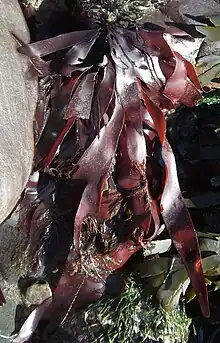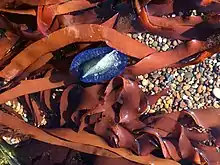| Palmaria palmata | |
|---|---|
 | |
| Scientific classification | |
| (unranked): | Archaeplastida |
| Division: | Rhodophyta |
| Class: | Florideophyceae |
| Order: | Palmariales |
| Family: | Palmariaceae |
| Genus: | Palmaria |
| Species: | P. palmata |
| Binomial name | |
| Palmaria palmata | |
| Synonyms [1] | |
| |
Palmaria palmata, also called dulse, dillisk or dilsk (from Irish/Scottish Gaelic duileasc/duileasg), red dulse, sea lettuce flakes, or creathnach, is a red alga (Rhodophyta) previously referred to as Rhodymenia palmata. It grows on the northern coasts of the Atlantic and Pacific Oceans. It is a well-known snack food. In Iceland, where it is known as söl [ˈsœːl̥], it has been an important source of dietary fiber throughout the centuries.
History
The earliest record of this species is on the island of Iona, Scotland where Christian monks harvested it over 1,400 years ago.[2]
Description
The erect frond of dulse grows attached by its discoid holdfast and a short inconspicuous stipe epiphytically on to the stipe of Laminaria or to rocks. The fronds are variable in shape and colour from deep rose to reddish purple and are rather leathery in texture. The flat foliose blade gradually expands and divides into broad segments ranging in size to 50 centimetres (20 in) long and 3–8 cm (1.2–3.1 in) in width which can bear flat, wedge-shaped proliferations from the edge.[3][4] The blade consists of an outer cortex of small cells enclosing a medulla of larger cells up to 0.35 thick.[5][6]
The reference to Rhodymenia palmata var. mollis in Abbott and Hollenberg (1976),[7] is now considered to refer to a different species: Palmaria mollis (Setchel et Gardner) van der Meer et Bird.[8][9]
Dulse is similar to another seaweed, Dilsea carnosa,[10] but Dilsea is more leathery with blades up to 30 cm (12 in) long and 20 cm (7.9 in) wide. Unlike P. palmata, it is not branched and does not have proliferations or branches from the edge of the frond, although the older blades may split.[11]
Life history
The full haplodiploid life history was not fully explained until 1980.[12] There are two phases in the life-history, with a haploid phase that is dioecious, with separate male and female plants. The large haploid plants are male, having sporangia. Spermatial sori occur scattered over most of the frond of the haploid male plant. The male plants are blade-like and produce spermatia which fertilize the carpogonia of the female crust. The female gametophyte is very small stunted or encrusted, the carpogonia, the female nucleus, apparently occurring as single cells in the young plants. The female plants are minute, less than 1 mm), and after fertilization become overgrown by the resulting diploid plant.[13] Tetraspores occur in scattered patches sori (spores) on the mature diploid blade. The adult tetrasporophyte produces tetraspores meiotically in fours.[3][14]
Ecology
P. palmata is to be found growing from mid-tide of the intertidal zone (the area between the high tide and low tide) to depths of 20 m or more in sheltered and exposed shores.[14]
Culinary use

Dulse is commonly used as food and medicine in Ireland,[15] Iceland, Atlantic Canada, and the Northeastern United States. It can be found in many health food stores or fish markets and can be ordered directly from local distributors. It is also used as fodder for animals in some countries.
Dulse is a good source of minerals and vitamins compared with other vegetables, contains all trace elements needed by humans, and has a high protein content.[2] Dulse contains iodine, which prevents goitre.
It is commonly found from June to September and can be picked by hand when the tide is out. When picked, small snails, shell pieces, and other small particles can be washed or shaken off the plant, which is then spread to dry. Some gatherers may turn it once and roll it into large bales to be packaged later.
Fresh dulse can be eaten directly off the rocks before sun-drying. Sun-dried dulse is eaten as is or is ground to flakes or a powder. When used in cooking, dulse's properties are similar to those of a flavour-enhancer. In Iceland, the tradition is to eat it with butter.. It can be pan-fried quickly into chips, baked in the oven covered with cheese, with salsa, or simply microwaved briefly. It can be used in soups, chowders, sandwiches, and salads, or added to bread or pizza dough. Finely diced, it can be used as a flavour enhancer in meat dishes, such as chili, in place of monosodium glutamate.
In Ireland dulse can be used to make "White Soda Bread".[16] In Ballycastle, Northern Ireland, it is traditionally sold at the Ould Lammas Fair. It is particularly popular along the Causeway Coast. Although a fast-dying tradition, many gather their own dulse. Along the Ulster coastline from County Down to County Donegal, it is eaten dried and uncooked as a snack. It is commonly referred to as dillisk on the west coast of Ireland. Dillisk is usually dried and sold as a snack food from stalls in seaside towns by periwinkle sellers.

Researchers at Oregon State University's Hatfield Marine Science Center have selected a fast-growing strain of Pacific dulse (P. mollis). Originally intended as a feed for abalone farming, they claim their strain of the seaweed tastes like bacon when fried.[17][18]
Distribution
P. palmata is the only species of Palmaria found on the coast of Atlantic Europe. It can be found from Portugal to the Baltic coasts and on the coasts of Iceland and the Faroe Islands.[19] It also grows on the shores of Arctic Russia, Arctic Canada, Atlantic Canada, Alaska, Japan, and Korea.[14] Records of P. palmaria from California are actually of Palmaria mollis.[9]
Parasites and diseases
Galls, possibly produced by parasitic nematodes, copepods, or bacteria, are known to infect these plants. They were recorded as "outgrowths of tissue produced by the presence...of an animal."[14][20]
References
- ↑ Michael D. Guiry (2015). Guiry MD, Guiry GM (eds.). "Palmaria palmata (Linnaeus) Weber & Mohr, 1805". AlgaeBase. National University of Ireland, Galway. World Register of Marine Species. Retrieved 8 February 2016.
- 1 2 Indergaard, M. and Minsaas, J. 1991. 2 "Animal and human nutrition." in Guiry, M.D. and Blunden, G. 1991. Seaweed Resources in Europe: Uses and Potential. John Wiley & Sons. ISBN 0-471-92947-6
- 1 2 Hoek, C.van den, Mann, D.G. and Jahns, H.M. 1995. Algae: An Introduction to Phycology. Cambridge University Press, Cambridge. ISBN 0-521-30419-9.
- ↑ "Algaebase". algaebase.org.
- ↑ Bunker, F.StP, Brodie, J.A., Maggs, C.A. and Bunker, A.R.2017. Seaweeds of Britain and Ireland Second edition, Wild Nature Press, Plymouth.UK.ISBN 978-0-9955673-3-7
- ↑ Irvine, L.M.1983. Seaweeds of the British Isles. Volume 1 Rhodophyta Part 2A ISBN 0-565-00871-4
- ↑ Abbott, I.A. and Hollenberg, G.J. 1976. Marine Algae of California. Stanford University Press, California. ISBN 0-8047-0867-3.
- ↑ Mondragon, J. and Mondragon, J. 2003. Seaweeds of the Pacific Coast. Sea Challengers, California. ISBN 0-930118-29-4.
- 1 2 "Algaebase". algaebase.org.
- ↑ "Algaebase". algaebase.org.
- ↑ Hiscock, S. 1986. A Field Key to the British Red Seaweeds. Occasional Publications No. 13. Field Studies Council, Dorset Press, Dorchester ISBN 1-85153-813-5.
- ↑ John P. van der Meer & Edna R. Todd (1980). "The life history of Palmaria palmata in culture. A new type for the Rhodophyta". Canadian Journal of Botany. 58 (11): 1250–1256. doi:10.1139/b80-155.
- ↑ Bunker, F.StP.D., Brodie, J.A., Maggs, C.A. and Bunker A.R. 2017. Seaweeds of Britain and Ireland Second Edition, Wild Nature press, Plymouth, UK ISBN 978-0-9955673-3-7
- 1 2 3 4 Irvine, L.M. & Guiry, M.D. "Palmariales and Rhodymeniales" in Irvine, L.M. 1983. Seaweeds of the British Isles. Volume 1. Part 2A. Cryptonemiales (sensu stricto) Palamriales, Rhodymeniales. British Museum (Natural History), London. ISBN 0-565-00871-4
- ↑ "Finest quality SeaVeg Irish Dulse, harvested from the clean waters of North West Donegal". seaveg.co.uk.
- ↑ Allen, R. Coast Recipes inspired by Ireland's Wild Atlantic Coast p.155 HarperCollins ISBN 978-0-00-746243-8
- ↑ "OSU researchers discover the unicorn – seaweed that tastes like bacon! - News & Research Communications - Oregon State University". oregonstate.edu. 2015-07-14.
- ↑ Helen Regan (16 July 2015). "New Seaweed Tastes 'Like Bacon' and Is Healthier Than Kale". TIME.com.
- ↑ Børgesen, F. (1903) Marine algæ. In: Botany of the Færöes Vol. II, pp. 339-532. Copenhagen and London.
- ↑ Ethel Sarel Barton (1891). "On the occurrence of galls in Rhodymenia palmata Grev". Journal of Botany, British and Foreign. 29: 65–68.
Further reading
- Grubb, V.M. 1923. Preliminary note on the reproduction of Rhodymenia palmata, Ag. Annals of Botany 37: 151–52.
- Pueschel, C.M. 1979. Ultrastructure of the tetrasporogenesis in Palmaria palmata (Rhodophyta). Journal of Phycology 15: 409–424.
- South, G.R. and Hooper, R.G. 1980. A Catalogue and Atlas of the Benthic Marine Algae of the Island of Newfoundland. pp. 1–136. Memorial University of Newfoundland Occasional Papers in Biology.
- Lennon, B.W. and Doyle, E. Wild Food. The O'Brien Press, Dublin. ISBN 978-1-84717-467-3
External links
- AlgaeBase
- Palmaria palmata Archived 2014-11-07 at archive.today at Michael Guiry's Seaweed Site
- . Encyclopædia Britannica. Vol. 8 (11th ed.). 1911. p. 653.
- . New International Encyclopedia. 1905.